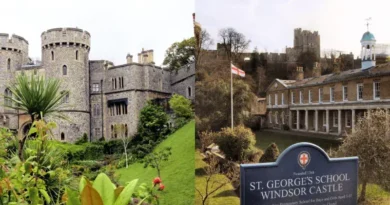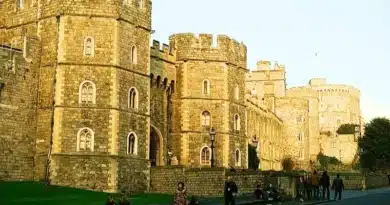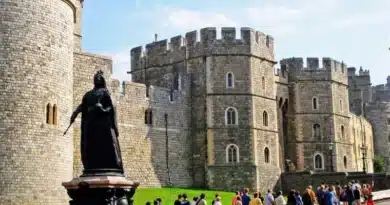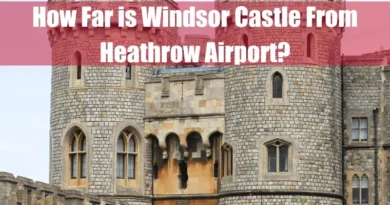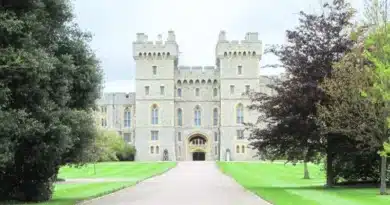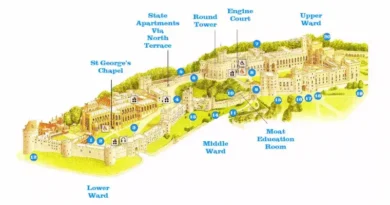How Far is Frogmore Cottage from Windsor Castle?
Key Takeaways
| Key Aspect | Details |
|---|---|
| Proximity | Frogmore Cottage is approximately 0.5 miles (0.8 kilometres) from Windsor Castle, with a walking time of about 10-15 minutes. |
| Area Detail | Frogmore Cottage is a 5,089 sq ft (472.8 m²) residence spreading over 30 acres. |
| Historical Context | The landscape is relatively flat, with few physical barriers, making travel between the two locations straightforward and accessible. |
| Geographical Features | The land between the two is part of the Windsor Estate, characterized by gently undulating terrain, manicured gardens, and ancient trees. |
| Walking Routes | The most direct and private route is through Home Park, with another scenic but public route through Windsor Great Park’s Long Walk. |
| Security and Privacy | High-security measures are in place, including surveillance and restricted access, ensuring privacy for royal family members living at Frogmore Cottage. |
| Historical Significance of Proximity | The close proximity has influenced how the royals use Frogmore Cottage, which has served as a practical extension of Windsor Castle over the years. |
| Transportation | While walking is common, vehicle access is also available via private roads restricted to authorized personnel. |
| Notable Landmarks | Key landmarks include the Frogmore Mausoleum and St. George’s Chapel, which are significant for their historical and cultural value. |
| Landscape and Barriers | The landscape is relatively flat with few physical barriers, making travel between the two locations straightforward and accessible. |
| Accessibility | The private nature of the estate ensures that the royal family can move discreetly between Frogmore Cottage and Windsor Castle. |
Let’s discuss in detail:
Introduction
Frogmore Cottage and Windsor Castle, both steeped in British history, are iconic royal residences that exemplify the balance of tradition and modern royal life. Situated within the private grounds of Windsor Castle in Berkshire, Frogmore Cottage, a Grade II listed building from the 19th century, is part of the expansive 30-acre Frogmore Estate. Windsor Castle, the world’s oldest and largest occupied castle, has been a principal residence for British monarchs for over 900 years.
The close proximity of these properties offers a unique blend of privacy and connectivity, allowing members of the royal family, such as the Duke and Duchess of Sussex, to enjoy seclusion while remaining near the heart of royal functions and family life at Windsor Castle.

Exact Distance and Walking Time
Measured Distance in Miles/Kilometers
The distance between Frogmore Cottage and Windsor Castle is approximately half a mile (0.8 kilometres). This short distance highlights the close connection between the two residences, both geographically and symbolically.
Approximate Walking Time Between the Two Locations
Walking from Frogmore Cottage to Windsor Castle takes about 10 to 15 minutes, depending on the route and walking pace. The paths are well-maintained, making it easy for residents and guests to move between the properties.
Comparison of Walking Routes
The most direct route between Frogmore Cottage and Windsor Castle goes through the private Home Park, offering privacy and a serene environment. A slightly longer route passes through Windsor Great Park’s public areas, providing scenic views of the estate. Both routes showcase the estate’s carefully maintained landscape.
Historical Context of Proximity
Historical Significance of Frogmore Cottage in Relation to Windsor Castle
Frogmore Cottage’s proximity to Windsor Castle is not a mere coincidence; it is steeped in historical significance. The Frogmore Estate has long been associated with the British royal family, particularly during Queen Victoria’s reign. The cottage itself, originally known as the Double Garden Cottage, was constructed for Queen Charlotte, the wife of King George III, and later became a favoured retreat for Queen Victoria’s mother, the Duchess of Kent.
Over the years, Frogmore Cottage has continued to serve as a residence for various members of the royal family, benefiting from its closeness to Windsor Castle. This closeness has allowed the cottage to function not just as a private home but also as a practical extension of the castle’s facilities, offering a quieter, more secluded space while still being within easy reach of the main royal residence.

How Proximity Has Influenced Royal Usage Over the Years
The short distance between Frogmore Cottage and Windsor Castle has significantly influenced how the cottage has been used by the royal family. While Frogmore Cottage itself does not have a strong historical record of being used for informal family gatherings during Queen Victoria’s reign, it has served various functions for the royal family over the years.
This tradition of using Frogmore Cottage as a private retreat has continued into the 21st century.
When Prince Harry and Meghan Markle moved into Frogmore Cottage in 2019, the proximity to Windsor Castle allowed them to participate in royal duties and family events while enjoying a degree of privacy not available at more central locations like Kensington Palace. Although their wedding reception was held at Frogmore House rather than the cottage, the close distance to Windsor Castle has continued to shape how these residences are used within royal life.
Geographical and Topographical Description
Detailed Description of the Grounds Between Frogmore Cottage and Windsor Castle
The land between Frogmore Cottage and Windsor Castle is part of the larger Windsor Estate, a sprawling area encompassing manicured gardens, woodland, and expansive lawns. The gently undulating terrain, with well-tended pathways that wind through the estate, provides easy access between the two properties. The landscape is quintessentially English, with a mix of formal gardens and natural features carefully preserved over the centuries.
The area is characterised by its peacefulness and seclusion, despite being close to one of the busiest tourist attractions in the UK. This blend of accessibility and privacy is a hallmark of the Windsor Estate, making it an ideal setting for royal residences. The grounds are also home to several ancient trees and carefully curated flower beds, adding to the sense of history and continuity that pervades the estate.
Overview of the Landscape and Any Physical Barriers
The landscape between Frogmore Cottage and Windsor Castle is relatively flat, with few physical barriers that would impede travel between the two locations. The main feature of the landscape is the Home Park, a private area reserved for the royal family. This parkland is carefully maintained, with smooth paths that make walking between the properties easy and enjoyable.
There are no significant barriers, such as rivers or steep hills, between the cottage and the castle, making the journey straightforward. The estate’s security fences are the primary boundaries, implemented to ensure the privacy of the royal family.
While these fences are designed to maintain the estate’s natural beauty, they are visible in certain areas, and access to the estate is carefully controlled.

Description of the Pathways and Access Points
The pathways connecting Frogmore Cottage and Windsor Castle are part of a network of routes that crisscross the Windsor Estate. These paths are primarily gravel or paved, making them accessible in all weather conditions. The main pathway between the cottage and the castle runs through the Home Park, offering a direct and private route for members of the royal family.
Estate security controls access points to these pathways, ensuring that only authorised personnel and guests can use them. This control is essential for maintaining the privacy and security of the royal family, particularly when high-profile events are taking place at Windsor Castle. The pathways are also lined with trees and shrubs, providing a natural screen that enhances the sense of seclusion as one walks between the residences.
Transportation Options
Best Routes for Walking
The most direct walking route from Frogmore Cottage to Windsor Castle is through Home Park, a private area reserved for the royal family. This route is the shortest and offers a quiet, scenic walk. The pathway is well-maintained and suitable for walking in most weather conditions. Another route is via the Long Walk, a public path through Windsor Great Park that leads directly to the castle gates. Although slightly longer, this route offers views of Windsor Castle but is less private and may be busier, especially during peak tourist seasons.
Accessibility for Vehicles
While walking is common, vehicle access between Frogmore Cottage and Windsor Castle is also available. The private roads within Windsor Estate are restricted to authorized personnel. These well-maintained roads provide a quick and convenient route for the royal family and their guests, even in bad weather.
Comparison of Public vs. Private Access to the Area
Public access near Windsor Castle is generally limited to the Long Walk and parts of Windsor Great Park. These areas are popular with tourists for their views and historical significance. However, Frogmore Cottage and its immediate surroundings are off-limits to the public to maintain the privacy of its residents.
Private access within the estate is tightly controlled, allowing the royal family to move discreetly between Frogmore Cottage and Windsor Castle without public intrusion.

Notable Landmarks Along the Way
Key Landmarks and Points of Interest Between the Two Locations
As one travels between Frogmore Cottage and Windsor Castle, several notable landmarks add to the historical and cultural significance of the journey. One such landmark is the Frogmore Mausoleum, the burial place of Queen Victoria and Prince Albert, located within the Frogmore Estate. This mausoleum, set in a peaceful garden, is an important site for those interested in royal history.
Another landmark is St. George’s Chapel, located within the grounds of Windsor Castle. This chapel, a masterpiece of Gothic architecture, is not only a place of worship but also the site of many royal weddings and funerals, including the recent wedding of Prince Harry and Meghan Markle. As one approaches Windsor Castle, the impressive silhouette of the Round Tower comes into view, a symbol of the castle’s long history and role as a royal fortress.
Description of the Home Park and Other Surrounding Features
The Home Park, which lies between Frogmore Cottage and Windsor Castle, is a private royal park that has been part of the Windsor Estate for centuries. This area is characterised by its expansive lawns, ancient trees, and carefully tended gardens.
The pathways through the Home Park are lined with historic features, including statues and memorials commemorating various events and figures from British history.
Security and Privacy Considerations
How Proximity Affects Security Measures for Both Properties
The proximity of Frogmore Cottage to Windsor Castle requires stringent security measures. The Windsor Estate has advanced security systems, including surveillance cameras, motion detectors, and a dedicated security team monitoring the area 24/7. The short distance between the two properties allows for integrated security protocols, ensuring that movements between them are closely monitored and potential threats can be quickly addressed. Private roads and pathways connecting the properties are secured, with access restricted to authorized personnel only.
Privacy Implications for Royal Family Members
Privacy is a key concern for the royal family members residing at Frogmore Cottage and Windsor Castle. The close proximity allows for easy communication and movement between the residences, which is crucial for maintaining their privacy. The estate’s design, with private gardens, secluded pathways, and controlled access points, ensures that family members can conduct their activities without public or media intrusion.
This setup provides a balance of proximity and privacy, allowing the family to fulfil public duties while enjoying a high level of seclusion.
Summary
The distance between Frogmore Cottage and Windsor Castle is a mere half mile, highlighting the close relationship between these two historic residences. This proximity has shaped the way the properties are used, offering a blend of privacy and accessibility that is essential for the royal family. From the carefully maintained pathways to the stringent security measures, every aspect of the Windsor Estate is designed to support the unique needs of its residents.
In conclusion, the distance between Frogmore Cottage and Windsor Castle is more than just a matter of geography; it reflects the enduring connections that bind the British royal family to their ancestral homes.
Whether viewed from a historical, geographical, or practical perspective, this proximity continues to play a vital role in the life of the Windsor Estate.
FAQ
What is Frogmore House?
Frogmore House is a historic royal residence located within the Frogmore Estate in Windsor Home Park, approximately half a mile south of Windsor Castle in Berkshire, England. Built between 1680 and 1684, it has served as a royal retreat for over three centuries. The estate’s name, “Frogmore,” is believed to derive from the numerous frogs that inhabited the marshy area.
Who built Frogmore House?
The house was constructed by architect Hugh May, who served under King Charles II, for his nephew, Thomas May, and his wife, Anne Aldworth. In 1792, Queen Charlotte, wife of King George III, purchased Frogmore House to use as a country retreat for herself and her unmarried daughters.
What is the historical significance of Frogmore House?
Frogmore House has been a private retreat for the British royal family since the 18th century. Queen Charlotte and her daughters used it as a country refuge, engaging in pursuits like Painting, drawing, needlework, and botany. Over the centuries, it has hosted various royal events and has been associated with several members of the royal family, including Queen Victoria’s mother, the Duchess of Kent.
Can the public visit Frogmore House?
Frogmore House is occasionally open to the public on select dates, often for charitable events. Typically, it opens for three days annually, with proceeds donated to selected charities. However, it is currently closed to visitors. For the latest information on public openings and ticket availability, it’s advisable to consult the Royal Collection Trust’s official website.
What are the main attractions within Frogmore House?
Frogmore House features notable attractions like the elegant Colonnade, the Cross Gallery, and Mary Moser’s Room, adorned with floral paintings by the 18th-century artist to reflect Queen Charlotte’s love of botany. Its celebrated gardens include a serene lake, wooded areas, and charming follies, enhancing its appeal as a royal retreat.
What is the connection between Frogmore House and Queen Victoria?
Queen Victoria’s mother, the Duchess of Kent, resided at Frogmore House from 1840 until she died in 1861. During this period, Queen Victoria frequently visited the house and had a close association with it.
Where is Frogmore House located?
Frogmore House is situated within the Frogmore Estate in Windsor Home Park, approximately half a mile south of Windsor Castle in Berkshire, England. The estate is part of the private grounds of Windsor Castle.
What is the architectural style of Frogmore House?
Frogmore House showcases a blend of 17th and 18th-century architectural styles. Between 1795 and 1804, architect James Wyatt made significant additions, including flanking pavilions and interior modifications, enhancing its neoclassical elements.
Who owns Frogmore House?
Frogmore House is part of the Crown Estate, which manages properties in the interest of the British monarch. While it remains under royal ownership, it is not used as a primary residence by any current royal family members.
What events have taken place at Frogmore House?
Frogmore House has hosted several royal events over the years. Notably, it was the venue for the wedding reception of Prince Harry and Meghan Markle in May 2018.
Is Frogmore House the same as Frogmore Cottage?
No, Frogmore House and Frogmore Cottage are distinct properties within the Frogmore Estate. Frogmore House is a large royal residence built in the 17th century, while Frogmore Cottage is a smaller dwelling constructed in 1801. Frogmore Cottage has been used as a residence by various royal family members, including, more recently, the Duke and Duchess of Sussex.
What are the gardens like at Frogmore House?
The gardens at Frogmore House are renowned for their serene landscapes, featuring a lake, wooded areas, and various follies. They reflect Queen Charlotte’s passion for botany and are considered a fine example of a late 18th-century English landscape garden.
Has Frogmore House been used recently?
Yes, Frogmore House continues to be used by the royal family for private events and receptions. While it is not a primary residence, it remains a venue for special occasions and family gatherings.
What is the Royal Mausoleum at Frogmore?
The Royal Mausoleum, located near Frogmore House, is the burial place of Queen Victoria and her husband, Prince Albert. Constructed between 1862 and 1871, it is a significant architectural and historical site within the Frogmore Estate.




